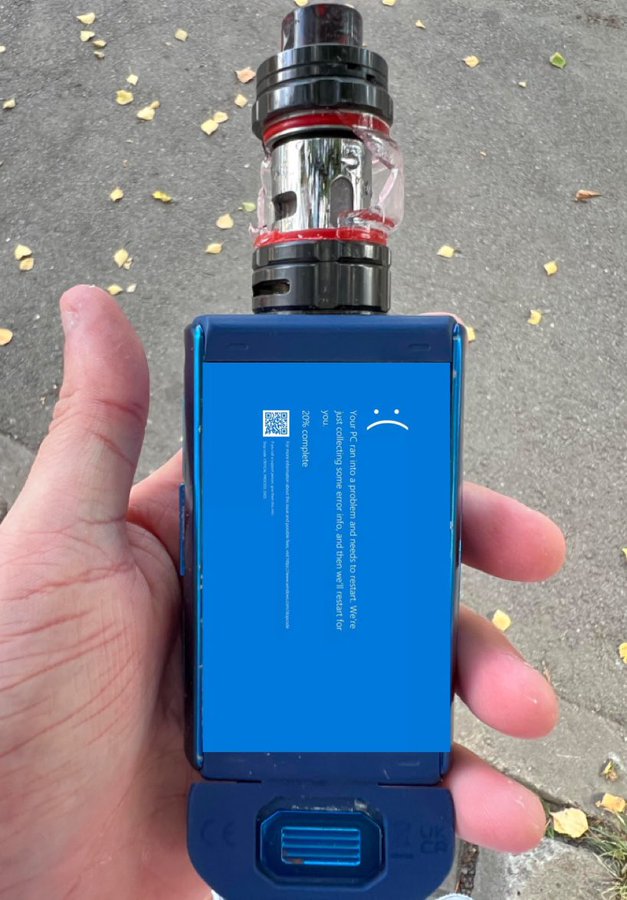Written by Matthew Collins.
Microsoft has announced its acquisition of a leading vaping company. The tech giant, known for its software and cloud services, has decided to dive into the world of e-cigarettes. Naturally, the internet is abuzz with speculation and confusion.
The official statement from Microsoft claims this acquisition is part of their mission to “embrace innovation and diversify our product offerings.” Critics, however, suggest that this might be a desperate attempt to remain relevant among the youth who are more interested in puffs than pixels. Bill Gates himself has remained suspiciously silent on the matter, leaving many to wonder if this was really his idea or if someone accidentally left the “buy” button unchecked.
In the meantime, Apple’s response has been nothing short of predictable. Tim Cook released a statement expressing his disappointment, noting that “Microsoft’s recent purchase clearly shows they are out of ideas.” The irony of Apple’s frequent “innovation” by removing headphone jacks and introducing dongles was not lost on the tech community.
Blue Screen of Death: A Targeted Phenomenon?
The plot thickened when reports started flooding in that the infamous Blue Screen of Death (BSOD) was now exclusively targeting Apple users. Yes, you heard that right. Microsoft’s notorious error screen, which has plagued Windows users for decades, has somehow found its way to Apple devices.
Microsoft engineers claim this is all in the name of equity. According to a leaked memo, the company believes that “everyone should experience the joys of a system crash, regardless of their operating system preference.” While this statement might seem like a poorly executed joke, affected Apple users are not laughing. Social media is filled with angry tweets and memes about Apple’s sudden descent into Blue Screen hell.
Conspiracy theories abound, with some suggesting that this is Microsoft’s subtle way of exacting revenge on Apple for years of perceived superiority. Others believe it’s just a glitch in the system, though that explanation lacks the delicious irony we’ve come to expect from tech rivalries.
Vaping and Tech: A Perfect Pair?
The decision to merge vaping with technology might seem baffling at first, but Microsoft insists it’s a match made in heaven. The company’s new range of smart vapes will feature touch screens, cloud connectivity, and yes, even a BSOD display for when you’ve had one puff too many.
The promotional materials promise an “unparalleled vaping experience,” complete with customizable nicotine levels, flavor profiles, and even the ability to sync your vape with your Xbox. Because nothing says “next-gen gaming” like blowing digital smoke rings while you wait for your Call of Duty match to load.
Critics, of course, are having a field day. Health experts have raised concerns about the potential risks of combining addictive substances with addictive technology. Parents are worried that their teenagers will now be even more glued to their screens, this time with the added bonus of nicotine addiction. And tech purists are lamenting the days when companies focused on perfecting their core products rather than branching out into unrelated markets.
Our Take
Microsoft’s latest escapade into the world of vaping and targeted Blue Screens might be the most hilariously misguided attempt at diversification we’ve seen. While the company’s effort to stay hip and relevant is almost endearing, the actual execution leaves much to be desired. For Apple users, the sudden appearance of the Blue Screen of Death feels like a bizarre cosmic joke, and for everyone else, it’s a cautionary tale of what happens when tech companies try too hard to innovate.
At the end of the day, Microsoft’s move might be great for meme creators and social media commentators, but it’s hardly a win for the public. Combining vaping with tech adds unnecessary complexity to a habit already under scrutiny for health reasons. And targeting Apple users with Blue Screens doesn’t level the playing field; it just makes Microsoft look petty.
This merger might be remembered as a footnote in tech history—a quirky anecdote about a time when Microsoft tried to vape its way back into the hearts of consumers. Or, it could signal a worrying trend of tech companies trying to dominate every aspect of our lives, one puff at a time.

